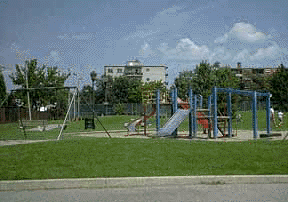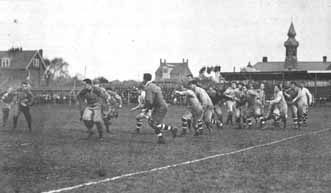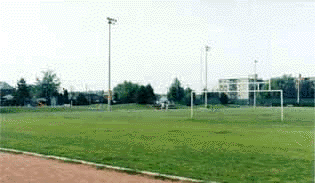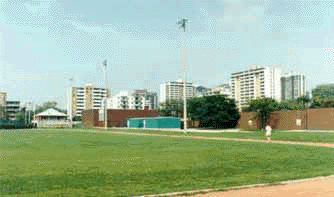
 Official Name:
Official Name:

The Hamilton Amateur Athletic Association (H.A.A.A.) grounds are the oldest sporting field in Hamilton. They were founded in 1874, when the Hamilton Cricket Club opened a field with seating for 150 at what was then the western border of Hamilton. The Tigers Rugby Football Club joined the Cricket Club at the field, by buying shares in the grounds in 1883. Together the two groups called themselves the Hamilton Amateur Athletic Association. By November 1890, the Hamilton Lawn Tennis Club, Albion Cricket Club and Ontario Football Club had joined the association and used the grounds along with the cricketers and football players. Later, lacrosse players would also join them.
In 1910, the H.A.A.A. asked the City to free it from paying taxes on the grounds, because the Association was offering the community a place for amateur sport. The Association really needed this break, because it was paying very large mortgage and management fees to keep the field open. The City thought that the Association was secretly planning to make a lot of money by eventually selling the grounds for building lots, so it did not give it the tax break.
To save the grounds, the Tigers Football Club bought a full one third of the shares in the grounds for $10,000, and invested an extra $13,000 in grounds improvements. The extra money paid for a grandstand that seated 2,318, change rooms, training halls, offices and a quarter mile running track with a 100 yard straight away for sprints. The eight foot wood fence was also replaced with a 12 foot high brick wall, which made more people pay to see games, instead of peeking through the fence for free. On October 8, 1910, the opening day of the season, the grandstands on the redeveloped grounds were packed to watch the Tigers beat the Ottawa Rough Riders.

On July 9, 1916, the Tiger Battalion paraded from the H.A.A.A. grounds to the train station on its way to fight in World War I. Many of the battalion's 602 soldiers were athletes and players on the different H.A.A.A. teams. After the war, a monument with the 25 names of Hamilton athletes who did not return from the war alive was unveiled at the Grounds. The Tigers held a religious service at the monument at the beginning of every season. The Prince of Wales honoured surviving Hamilton veterans with medals at the grounds on October 18, 1919.
On September 27, 1927, at the end of a practice, football players at the H.A.A.A. grounds noticed the northeast section of the main grandstand had caught fire. The flames, fed by a strong northeast wind, spread quickly to the rest of the grandstand. The heat became so intense, that it twisted the grandstand's metal supports, causing the roof to cave in. Many uniforms, club records and some players' clothing in the offices and change rooms under the grandstand were lost. The area around the grounds was packed with 1,500 cars owned by people who came to watch the grandstand burn. Many even sat in the open bleachers across from the burning grandstand to get a better view of the flames.
 The fire began to spread to several houses on Reginald St., next to the grandstand. While these houses and their contents did get a lot of smoke and water damage, they were saved by the constant downpour the firefighters kept on them. Total damages caused by the fire over the two hours and 20 minutes totalled almost $100,000. The fire was believed to be caused either by boys playing with matches, or a cigarette butt that may have fallen into some papers. The grandstand was rebuilt the following year.
The fire began to spread to several houses on Reginald St., next to the grandstand. While these houses and their contents did get a lot of smoke and water damage, they were saved by the constant downpour the firefighters kept on them. Total damages caused by the fire over the two hours and 20 minutes totalled almost $100,000. The fire was believed to be caused either by boys playing with matches, or a cigarette butt that may have fallen into some papers. The grandstand was rebuilt the following year.
In 1945, the H.A.A.A. sold the grounds to the Parks Board for $7,000 in tax debts, on the condition that the football and tennis clubs would get the first choice of using the property. The following year, the western grandstand was moved to the east side of the grounds offering seating for a total of 4,200 people.
 The Tigers played at the grounds until 1960, when the team moved to the Civic Stadium, later Ivor Wynne Stadium. High schools and junior leagues took over the Grounds in their place.
The Tigers played at the grounds until 1960, when the team moved to the Civic Stadium, later Ivor Wynne Stadium. High schools and junior leagues took over the Grounds in their place.
In 1975, as part of the federal Neighbourhood Improvement Programme, the H.A.A.A. grounds were re-developed into more of a public park. The monument, brick fence, brick clubhouse and grandstand were pulled down, lights were installed, and the main clubhouse was rebuilt with showers and washrooms. 50 % of the $395,000 needed for the work was supplied by the federal government, while the City and Province each gave 25 %. The renewed H.A.A.A. site was reopened on September 10, 1977. A parade of majorettes, cub and scout groups, the fire department band and antique cars carrying government officials led from Victoria Park to the site. At the park, 2,000 people enjoyed fireworks, a balloon-blowing contest by local politicians, puppets, mimes, music, miniature train rides, running races and a skateboarding demonstration.

In 1989, the monument to the Hamilton war dead was recovered, when a relative of one of the honoured soldiers asked the Parks Division to locate it. A careful search of downtown storage found the plaque under a pile of maps and plans. The stone on which it was mounted was found face up on the edge of a Parks parking lot on the Mountain, acting as a bumper block. Both parts of the monument were cleaned, repaired, and unveiled at the grounds a second time on September 22, 1989.
On March 29 1994, City Council approved a Canada Remembers project at the park run by the Hamilton Historical Board and the United Council of Veterans. From 1994 to 1995, together they restored a 77mm German artillery field gun, and placed it at the H.A.A.A. site as a veteran's memorial.
In 1995 a sugar maple was planted by the tennis courts as a part of the Green Streets Canada program.
